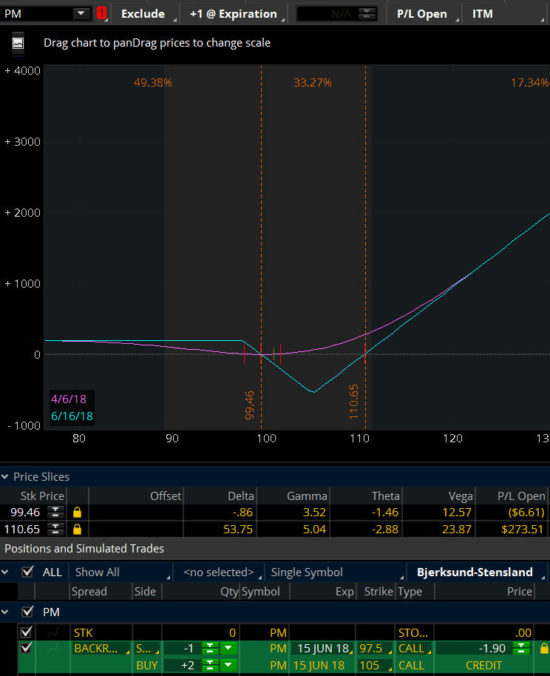The ratio backspread is a strategy used by traders to create a position with a limited loss and varying degrees of profit. If the trade goes against you and the position is setup correctly, it can help guard against a large loss. This can be useful, especially when there is major news or a “black swan” event.
The ratio backspread can be implemented when a trader is expecting a substantial move in the price of the underlying asset. If the price of the underlying asset does not move much, it can create a loss for a ratio backspread. The ratio backspread can be entered either as a debit or a credit. Ratio backspreads can be created using call options or put options.
This strategy is referred to as a “backspread” due to there being a greater number of contracts written on the long side of the position.
Guidelines for this strategy…
As with any strategy, there are multiple methods to create and trade a ratio backspread. Guidelines for the ratio backspread are:
• Make an assumption on the directional bias of the underlying
• Use an option expiration which allows enough time for the trade to mature (around 60 to 65 DTE)
• Look for an option about 65 days till expiration, which has similar Implied Volatility in relation to the other option expiration cycles
• When selling the option, look for around a 65 delta
• When buying the option, look for around a 35 delta
• Check margin to be sure it is not too large for the trading account (high priced underlyings can be pricey)
• Look for a credit to enter the position of at least $1.50 for a 1 X 2 ratio backspread
The Bull Call Ratio Backspread
The bull call ratio backspread is a bullish strategy. To create the position for this example, the trader is selling one In-the-Money call option and buying two higher strike Out-of-the-Money call options using an underlying asset with the same expiration date. For the most part, the trader will have a bullish bias and is looking for a significant move to the upside. Traders who use this strategy will be looking for a bullish move to the upside to create a profit. At the same time, if the underlying asset does not move to the upside the risk is limited.
The bull call ratio backspread can be a good strategy in volatile markets.
Neutral or sideways price action is not good for this strategy. When and if the underlying asset does not move up or down in price, the option values will tend to decrease and lose money.
It is important for a trader to monitor the position at all times, and especially as it approaches expiration. If the underlying price does not move, the trader may want to close the position.
What is the Profit Potential?
Theoretically, the underlying has no limit of potential movement to the upside. Therefore, this option strategy has unlimited profit potential within the expiration time period of the option.
The trader can also make a profit by the underlying falling in price, if the position is constructed by receiving a credit when the position is opened.
What is the Maximum Loss?
If the position expires in between the expiration breakeven points on the risk graph, there will be varying degrees of a loss. If the underlying asset should expire and close at the upper strike price, the maximum loss would occur. This is because the two long calls would expire worthless and the short call would close In-the-Money.
Below is an Example of a Bull Call Ratio Backspread where the trader is expecting a move to the upside …

Figure A: Call Ratio Backspread entered 4/06/2018 entered 70 days prior to expiration.
For the purposes of today’s discussion, the position is created by selling one In-the-Money Call option and buying two Out-of-the-Money Call options on the underlying asset PM. Ratio backspreads can have varying ratios of short options to long options, such as a 1 to 2, a 2 to 3, a 2 to 4,a 3 to 5 etc…
The position was created by selling one PM 15JUN 18 97.5 Call option and buying two PM 15JUN 18 105 Call options. The trade was entered for a credit of $1.90. The delta of the short call option was 70. The delta of the two long options was 35. The maximum risk for the trade is calculated by taking the margin of $750.00, minus the credit ($190.00), which would be a $560.00 maximum risk/ loss. The volatility of the option expiration was about 24, which was similar to the other option expirations.
The assumption for this call ratio backspread is a good move to the upside. The purple line on the risk graph shows the potential profit and loss for the position. As you can see at trade entry, the purple line dips slighty below the zero line on the risk graph when the trade is entered. This shows there is a potential small loss at trade entry. As the trade matures and gets closer to expiration, the risk of a loss will tend to increase if the price of the underlying remains within the expiration breakeven points.
The blue line on the risk graph shows the potential loss when the options expire. As you can see the blue line dips below the zero line on the risk graph. The largest dip on the risk graph is at the long strikes, which indicates the greatest potential loss at expiration.
Did you notice the blue expiration line to the left on the risk graph? It shows a potential profit of $190.00, which is the credit or premium received at trade entry. This is one of the benefits of a bull call ratio backspread which is entered for a credit. If the position goes against the trader, it has the potential to produce a profit.
The expiration breakeven points for the position are shown on the risk graph by the 99.46 and 110.65 price slices. If the underlying closes inside the expiration breakeven points, the trade will have varying degrees of a loss. If the trade closes outside the two breakeven points there will be varying degrees of profit.
Do you want to learn from veteran traders who are will to share openly?
Join Aeromir today. It’s free…
Summing it up…
The bull call ratio backspread is, for the most part, a combination of a Bear Call Option Spread with an extra long call option. If it is possible to receive a credit at the trade entry, this will structure the position to potentially make money if the trade goes completely against the original bias of the trader. This is accomplished by selling the short call option for more premium than it costs to purchase the two long call options.
This can be a good strategy for volatile markets and underlying assets. The position can give the trader an edge when the trade is properly constructed.
It is highly recommended to learn this position in a paper trading account. See how the trade preforms before trading it in a live account. When you can get a consistent, profitable winning record using the bull call ration backspread, then it could be time to go live.
Please comment below to add any experiences or knowledge you have about the bull call ratio backspread.


